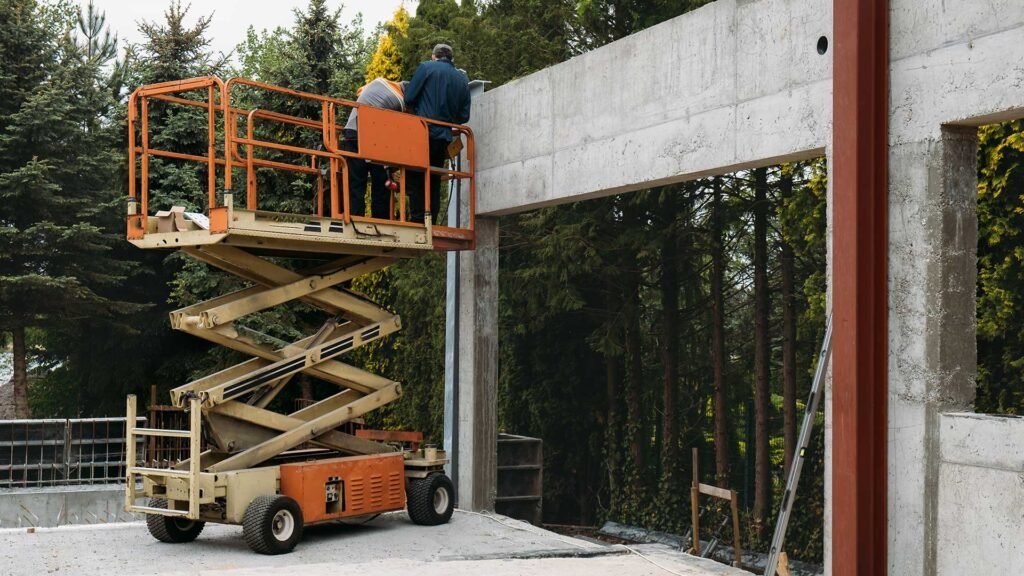In the fast-paced world of construction, deadlines loom large, and efficiency reigns supreme. When tackling projects requiring elevated access, renting the right aerial work platform can make all the difference. But with various options like scissorlifts, boomlifts, and telehandlers available, choosing the most suitable equipment can be a challenge for contractors.
This comprehensive guide dives into the functionalities, applications, and key considerations for renting scissorlifts, boomlifts, and telehandlers. By understanding the strengths of each platform, you’ll be equipped to make informed decisions that maximize safety, productivity, and cost-effectiveness on your next project.
Scissorlifts: The Workhorses of Elevated Work
What are they? Scissorlifts, recognizable by their vertical rise and scissor-like mechanism, provide a stable and secure platform for workers and materials at various heights. They excel in offering exceptional platform capacity and are ideal for straight-up-and-down tasks.
Common applications:
- Installation and maintenance (electrical, HVAC, plumbing)
- Drywalling and painting
- General construction tasks (interior and exterior)
- Window cleaning
Key considerations:
- Platform height: Scissorlifts come in various working heights, so choose one that reaches the required level for your project.
- Platform capacity: Ensure the platform can accommodate the weight of workers, tools, and materials.
- Electric vs. gas-powered: Electric models are ideal for indoor use due to quiet operation and zero emissions, while gas-powered models offer greater power for outdoor applications.
- Drive options: Self-propelled scissorlifts enhance maneuverability on the job site.
Boomlifts: Reaching New Heights with Versatility
What are they? Boomlifts, featuring a hydraulic arm that extends and articulates, offer exceptional reach and flexibility. They are ideal for projects requiring access to overhead areas with obstructions or uneven terrain.
Common applications:
- Construction (roofing, framing, siding)
- Electrical work (power line installation and maintenance)
- Tree trimming and landscaping
- Sign installation and maintenance
- Window cleaning on high-rise buildings
Key considerations:
- Articulation: Choose a boomlift with the necessary articulation (knuckle or telescopic) to navigate around obstacles and reach specific work zones.
- Up-and-over reach: Ensure the boom’s horizontal reach allows for precise positioning over uneven surfaces or obstructions.
- Platform capacity: Consider the weight of workers, tools, and materials when selecting the appropriate platform capacity.
- Drive options: Similar to scissorlifts, boomlifts come in self-propelled and towable models.
Telehandlers: Material Handling Masters
What are they? Telehandlers, also known as telescopic handlers, combine a telescopic boom with a forklift attachment, offering exceptional lifting capacity and reach for heavy materials.
Common applications:
- Construction (steel erection, placing trusses, loading/unloading materials)
- HVAC (installing rooftop units)
- Landscaping (placing trees, transporting large rocks)
- Industrial applications (loading machinery, maintenance tasks)
Key considerations:
- Lifting capacity: Telehandlers come with varying lifting capacities to accommodate different load weights.
- Lifting height: Select a telehandler with the required boom reach to access specific work zones.
- Attachment options: Telehandlers can be equipped with various attachments like forks, buckets, winches, and personnel platforms to suit diverse needs.
Choosing the Right Equipment: A Contractor’s Checklist
Here’s a quick checklist to guide your selection process:
- Project requirements: Identify the specific tasks your crew will be performing and the necessary working height and reach.
- Worksite environment: Consider factors like space constraints, ground conditions (indoor/outdoor, uneven terrain), and accessibility.
- Material handling needs: Evaluate the weight and type of materials you’ll be lifting or transporting.
- Budget: Compare rental rates for different equipment types based on your project duration.
- Safety: Always prioritize safety by ensuring your crew receives proper training for operating the chosen equipment.
Conclusion
By understanding the distinct capabilities of scissorlifts, boomlifts, and telehandlers, contractors can make informed decisions when renting aerial work platforms. Remember, consulting with a reliable equipment rental company, like Strait Way rentals can provide valuable insights and ensure you secure the most suitable equipment for your project’s success.

